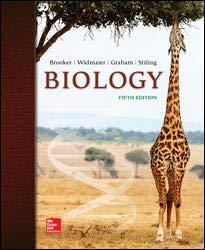
Concept explainers
Introduction: A skeleton is a structure that provides support and protection. It plays an important role in locomotion. Exoskeleton and endoskeleton are the two major types of skeletons found in animals.
Answer to Problem 1TY
Correct answer: A disadvantage of an exoskeleton is that it must be periodically shed. This leave the animal in a vulnerable state. Hence, the correct answer is option b.
Explanation of Solution
Reason for correct answer:
Exoskeletons provide support for the body and protection from the external environment and predators. It plays an important role in the protection of internal organs. They must be periodically shed and replaced in order to allow the growth of the animal. However, the new exoskeleton formed is soft, making the animal more vulnerable to predators and the environment.
Option b. is given as “must be periodically shed, leaving the animal in a vulnerable state”.
The periodic shedding of exoskeleton makes the animal more vulnerable to predators and the environment. This is because, the new exoskeleton formed is soft. Hence, the correct answer is option b.
Reasons for incorrect answer:
Option a. is given as, “cannot protect an animal’s internal organs”.
Exoskeleton plays an important role in the protection of internal organs. It is not a disadvantage of an exoskeleton. Hence, option a. is incorrect.
Option c. is given as, “does not provide any flexibility for the ease of movement of an animal”.
Exoskeletons are tough, durable, and segmented to provide flexibility and to allow movement. Hence, option c. is incorrect.
Option d. is given as, “is a soft, easily damaged structure”.
Exoskeletons are tough and durable. The new exoskeleton formed after molting is soft. Hence, option d. is incorrect.
Option e. is given as, “cannot protect the outside of the body surface”.
Exoskeleton surrounds and protects most of the body surface. It is not a disadvantage of exoskeleton in animals. Hence, option e. is incorrect.
Hence, the options a., c., d., and e. are incorrect.
Thus, a disadvantage of an exoskeleton is that it must be shed periodically. This leave the animal in a vulnerable state.
Want to see more full solutions like this?
Chapter 45 Solutions
BIOLOGY-TEXT
- Molecular Biology Question A gene that codes for a protein was removed from a eukaryotic cell and inserted into a prokaryotic cell. Although the gene was successfully transcribed and translated, it produced a different protein than it produced in the eukaryotic cell. What is the most likely explanation?arrow_forwardMolecular Biology LIST three characteristics of origins of replicationarrow_forwardMolecular Biology Question Please help. Thank you For E coli DNA polymerase III, give the structure and function of the b-clamp sub-complex. Describe how the structure of this sub-complex is important for it’s function.arrow_forward
- Molecular Biology LIST three characteristics of DNA Polymerasesarrow_forwardMolecular Biology RNA polymerase core enzyme structure contains what subunits? To form holo enzyme, sigma factor is added to core. What is the name of the structure formed? Give the detailed structure of sigma factor and the function of eachdomain. Please help. Thank youarrow_forwardMolecular Biology You have a single bacterial cell whose DNA is labelled with radioactiveC14. After 5 rounds of cell division, how may cells will contain radioactive DNA? Please help. Thank youarrow_forward
- 1. Explain the structure and properties of atoms and chemical bonds (especially how they relate to DNA and proteins). Also add some pictures.arrow_forward1. In the Sentinel Cell DNA integrity is preserved through nanoscopic helicase-coordinated repair, while lipids in the membrane are fortified to resist environmental mutagens. also provide pictures for this question.arrow_forwardExplain the structure and properties of atoms and chemical bonds (especially how they relate to DNA and proteins). Also add some pictures.arrow_forward
- In the Sentinel Cell DNA integrity is preserved through nanoscopic helicase-coordinated repair, while lipids in the membrane are fortified to resist environmental mutagens. also provide pictures for this question.arrow_forward1. Explain how genetic information is stored, copied, transferred, and expressed. Also add some pictures for this question.arrow_forward!. Describe biological macromolecules (DNA, RNA, proteins, lipids, etc.) and how they function in the cell. also provide some images for this question.arrow_forward

 Human Physiology: From Cells to Systems (MindTap ...BiologyISBN:9781285866932Author:Lauralee SherwoodPublisher:Cengage Learning
Human Physiology: From Cells to Systems (MindTap ...BiologyISBN:9781285866932Author:Lauralee SherwoodPublisher:Cengage Learning Biology: The Dynamic Science (MindTap Course List)BiologyISBN:9781305389892Author:Peter J. Russell, Paul E. Hertz, Beverly McMillanPublisher:Cengage Learning
Biology: The Dynamic Science (MindTap Course List)BiologyISBN:9781305389892Author:Peter J. Russell, Paul E. Hertz, Beverly McMillanPublisher:Cengage Learning Medical Terminology for Health Professions, Spira...Health & NutritionISBN:9781305634350Author:Ann Ehrlich, Carol L. Schroeder, Laura Ehrlich, Katrina A. SchroederPublisher:Cengage LearningLifetime Physical Fitness & WellnessHealth & NutritionISBN:9781337677509Author:HOEGERPublisher:Cengage
Medical Terminology for Health Professions, Spira...Health & NutritionISBN:9781305634350Author:Ann Ehrlich, Carol L. Schroeder, Laura Ehrlich, Katrina A. SchroederPublisher:Cengage LearningLifetime Physical Fitness & WellnessHealth & NutritionISBN:9781337677509Author:HOEGERPublisher:Cengage





